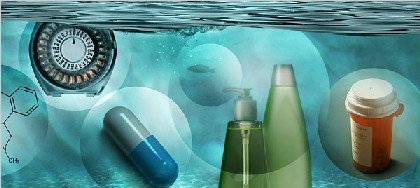Dr. Bryan Brooks on how drugs and soaps are contaminating rivers, oceans and drinking water
Listen Now Download the show by right-clicking the link.

Image: watersecretsblog.com
This week’s guest, Dr. Bryan Brooks, is an Associate Professor of Environmental Science at Baylor University in Texas. He has given over
60 invited presentations and lectures in the United States, United Kingdom, France, Poland, Portugal and Australia on the water quality dynamics of rapidly urbanizing regions. Dr Brooks is particularly interested in contaminants like pharma-ceuticals, personal care products and endocrine active substances, and the way in which these chemicals - as well as the excretion of medical drugs - affect the ecosystem and marine environment in which they end up. Read Baylor Begins First National Study On Pharmaceutical Contaminants, Personal Care Products in Fish Tissue.
In this interview, Dr. Brooks starts off by defining the term “PPCP” (pharmaceuticals and personal care products) as first used in the Journal of Environmental Health Perspectives. These PPCPs are entering the wastewater stream as consumers excrete or throw away drugs, and as they use shampoos, detergents and other body care goods that are washed down the drain. See the EPA’s Pharma-ceuticals and Personal Care Products as Pollutants (PPCPs) page.
Dr. Brooks is asked which surfactants or soaps are having adverse effects on aquatic life. Dr. Caldicott brings up the topic of antimicrobial soaps and other anti-germ agents, and what she calls an obsessive drive to sell people products that over-sterilize bathrooms and kitchens, when in fact we must live with some bacteria to develop our resistance. Read Cleaning Up Antimicrobial Hand Soaps and Warning: Toxic Chemical Triclosan Can Turn Your Toothpaste or Bathroom Soap into Chloroform about the negative aspects of these cleansers.
Dr. Brooks says scientists are assessing if current approaches to assess the environmental impact of PPCPs and hormone-disrupting chemicals are stringent enough & have the right design. He refers to the effects of water pollutants on alligator sexual development. Read the PBS Frontline Fooling with Nature feature, “Teeny Weenies.” Dr. Brooks also mentions the study by John Sumpter, Feminized responses in fish to environmental estrogens.

Dr. Caldicott refers to recent medical literature about more boys being born with smaller-than-normal or malformed penises, and she says we are definitely seeing the results of unstudied chemicals entering the environment. Read It’s official: Men really are the weaker sex: Evolution is being distorted by pollution, which damages genitals and the ability to father offspring, says new study.
The program discusses antibiotics in animals, and the growth of antibiotic-resistant bacteria, before Dr. Caldicott asks Dr. Brooks to explain his findings on antidepressants and other pharma-ceutical drugs which are ending up in rivers (and other studies find, in tap water). Dr. Brooks says he found Prozac and Zoloft in fish. He describes how fish affected by antidepressants lose their ability to catch prey. Read Study: Pharma-ceuticals Found in North Texas Fish: Human drugs show up in fish caught near wastewater treatment plants about one of Dr. Brooks’s studies.
Dr. Brooks says the notion of mixtures is part of our lives with the advent of chemicals, and the challenge for scientists is to find the consequences in aquatic life of mixtures of drugs excreted or thrown by humans. Read the full text of Effects and Interactions in an Environmentally Relevant Mixture of Pharmaceuticals which describes a study of drug combinations similar to those combinations entering the water supply on the health of fish. Dr. Caldicott emphasizes that the EPA must become more involved in investigating the chemical cocktail humans and other creatures are forced to live in now.
To read more on the topics in this week’s program, see Endocrine Disruption Found in Fish Exposed to Municipal Wastewater and Cancer Drugs Found in Tap Water and Fish in U.S. Rivers Tainted With Common Medications and AP: Drugs found in drinking water and Benadryl, Antidepressants Found Tainting US Rivers
and Earthwatch – drugs in the water and Tests for drugs in tap water and How Drugs Can Contaminate Drinking Water.
Read Dr. Brooks’s paper, Ecotoxicological Investigations In Effluent-Dominated Stream Mesocosms (161 pages, 2002) and read an abstract of Dr. Brooks’s 2005 study Determination Of Select Antidepressants In Fish From An Effluent-Dominated Stream.
